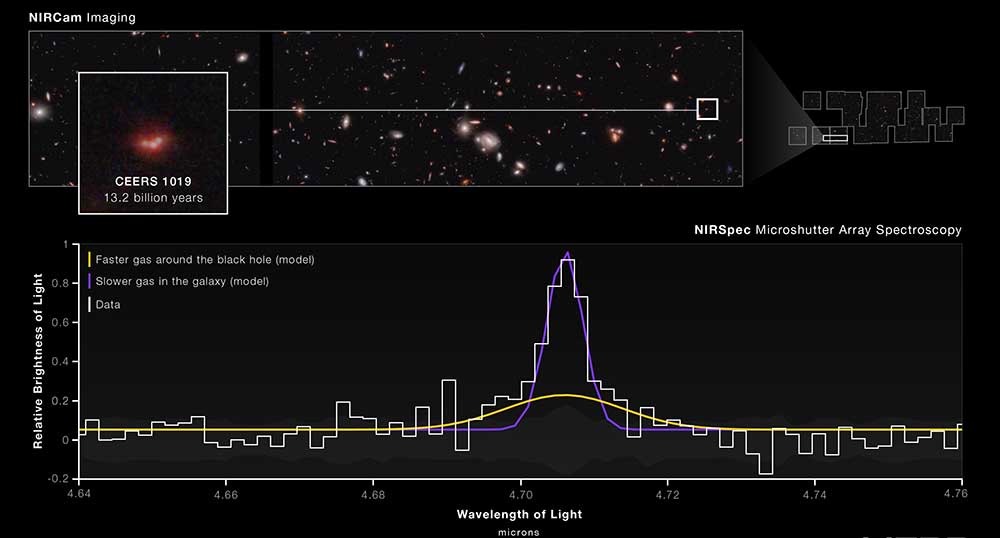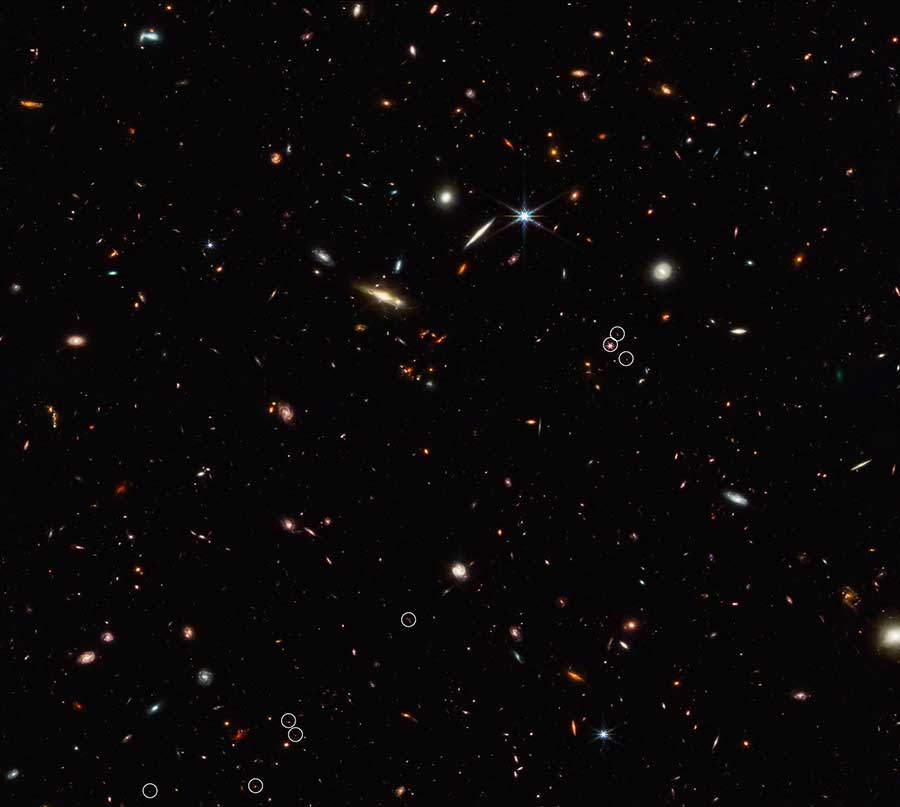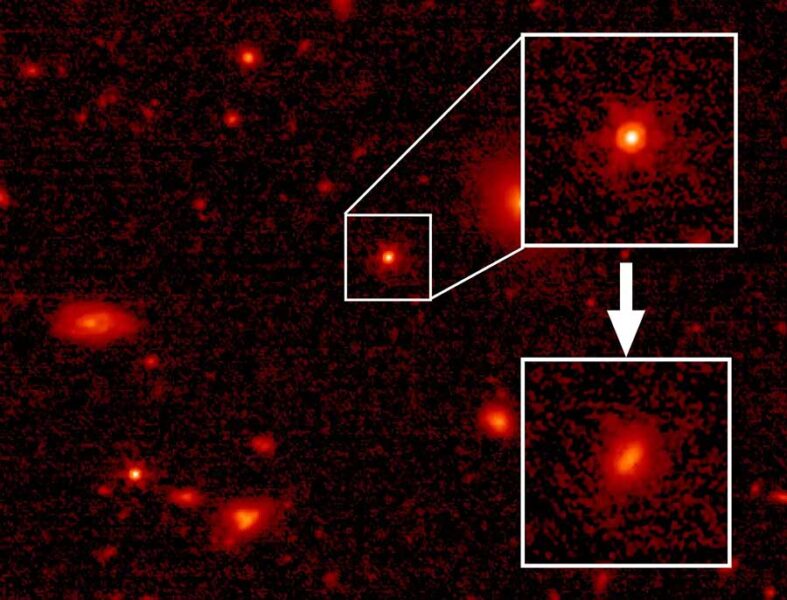The intrepid infrared explorer is offering astronomers a jump back in time, enabling them to see quasars at earlier times than ever before.
The James Webb Space Telescope (JWST) has looked back to when the universe was in its infancy and found black holes already containing the mass of hundreds of millions of Suns. This new window on the early universe, as reported in four new studies, shows a view surprisingly similar to the one closer to home.
We don’t see supermassive black holes directly, of course. It’s the gas around them that heats up and glows as it swirls into the maw of feeding black holes, known as quasars. The emitted light is brightest at ultraviolet wavelengths, but those wavelengths stretch as they pass through the expanding universe to Earth, putting the light of distant quasars right in the range of JWST’s sensitive infrared capabilities.
“It’s a fun time for the quasar community!” exclaims Karl Gebhardt (University of Texas at Austin), who was not involved in the three studies. “I’m loving watching and reading about the JWST data coming in regarding black holes in the early universe.”
Four new studies focus on 11 quasars dating back to the cosmic dawn. One of these, led by Rebecca Larson (Rochester Institute of Technology), reports the most distant quasar known — just 580 million years after the Big Bang (at a redshift of 8.7). Despite the youth of the universe in which this quasar resides, it has already grown to hold 9 million Suns' worth of mass. This study, part of the the Cosmic Evolution Early Release Science (CEERS) survey, will appear in Astrophysical Journal Letters.

NASA
Eight additional quasars come from the ASPIRE program (somehow short for “A Spectroscopic Survey of Biased Halos in the Reionization Era”), which is designed to observe 25 quasars in total. Astronomers had previously found the black holes that power these eight quasars to range from 600 million to 3 billion solar masses. (For comparison, our galaxy’s central black hole has a mass of only 4 million Suns.) More precise measurements from JWST confirm that the prior measurements were roughly correct, albeit slightly overestimated: the sample’s new mass range is from 600 million to 2 billion Suns. The result, Jinyi Yang (Steward Observatory) and colleagues report in Astrophysical Journal Letters, confirms the existence of billion-solar-mass black holes some 800 million years after the Big Bang.
In a third study in Astrophysical Journal Letters, Feige Wang (also at Steward Observatory) and colleagues find that one of these eight quasars is part of a much larger cosmic structure. This quasar and 10 other galaxies all lie along a filament that’s twice as long as it is wide. Each galaxy is brimming with newborn stars, revealed by the characteristic signature of doubly ionized oxygen. The filament is gigantic, spanning a couple arcminutes on the sky and millions of light-years in space.

NASA / ESA, CSA / Feige Wang (University of Arizona); Image processing: Joseph DePasquale (STScI)
Wang’s team makes the case that this structure is actually a galaxy cluster in the making. But he cautions that because the protocluster is still coming together, it’s much larger than its grown-up siblings. “[Protoclusters] are still in the early stages of their evolution and have not yet developed into fully formed clusters,” Wang explains. “These structures serve as excellent indicators of large-scale galaxy overdensities or the underlying dark matter density in the early universe.”
As serendipitous as this find was, the biggest revelation came in a fourth study, published in Nature. Xuheng Ding (University of Tokyo) and colleagues observed another two quasars that were first detected by the Hyper Suprime-Cam on the Subaru Telescope on Mauna Kea, Hawai‘i.
Generally, a supermassive black hole’s feeding frenzy outshines its entire host galaxy, especially at such extreme distances. But JWST’s eagle-eyed cameras have let astronomers disentangle the two for these systems. And here’s where astronomers found something unexpected.
For decades, astronomers have noticed that quasars and their host galaxies appear to grow together. This, despite the fact that even supermassive black holes don’t have the gravitational reach to affect much beyond their immediate surroundings. Perhaps, some theorized, a feeding black hole powers jets or winds or some other form of feedback that then regulates both its own growth and that of its host galaxy, so that the two grow in tandem. If that were the case, then we might expect that galaxies and the black holes they host would relate differently to each other over cosmic time as they interact.
However, Ding’s team found that, at least for the two quasars they examined, the relation between the black hole mass and galactic stellar mass is exactly what we observe in nearer quasars. (Interestingly, the more recently discovered CEERS quasar also matches this relation, even though it hails from even earlier times.)
Gebhardt says he’s surprised at the result. “It’s a really hard measurement to get the stellar mass, and my initial reaction when reading the abstract was to be skeptical,” he adds. “But [the researchers] have done a great job throughout.”

Ding, X., Onoue, M., Silverman, J.D. et al.
It could be that the supermassive black holes in these two galaxies have already powered feedback even at such early times. These two quasars might even be fast-evolving outliers that are not representative of the evolution of most galaxy–black hole pairs. While two data points aren’t enough to draw firm conclusions, there are many more early quasars awaiting JWST observation. Soon, our window on the early evolution of supermassive black holes will expand into a fuller picture.
 1
1









Comments
skynr13
July 8, 2023 at 10:04 pm
Could it be that when the Big Bang occured or was occurring that some particles were created and formed black holes directly? Even that certain areas of space were affected to this point and more mass accumulated there and caused Quasar alignments like in this example? Mass and dust would be highly concentrated in this area too, and would account for the brightness of the Quasar and it's Galaxy.
You must be logged in to post a comment.
You must be logged in to post a comment.